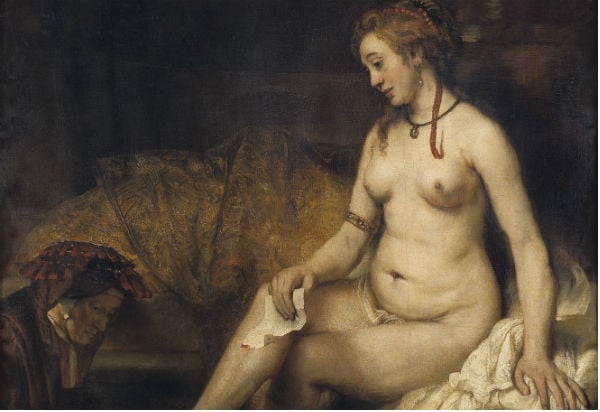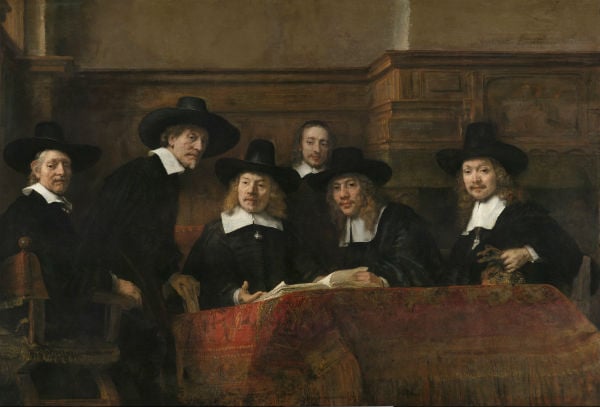Art & Exhibitions
Rembrandt, Magnificent in Old Age at London’s National Gallery
JJ Charlesworth is enthralled by the Dutch Master’s late works.

JJ Charlesworth is enthralled by the Dutch Master’s late works.

JJ Charlesworth

You get old, maybe you don’t care too much what others think of you. Rembrandt Van Rijn, certainly, had a tough life towards the end, losing his first wife and his son, and becoming poor and indebted when he had once been rich. Yet as Rembrandt: the Late Works proposes, the Dutch master’s talent as a painter and insight as an artist seems only to have grown more emphatic and demanding, as if adversity allowed him to abandon the etiquette and conventions of his trade, to focus on what his art was capable of, regardless of patrons, reputations, and the whims of fashion and the market.
Paintings, etchings, and drawings are assembled here, dating from the early 1650s to the artist’s death in 1669, aged 63. People will come for the painted portraits and self-portraits alone, but the show’s compact hang gives the context of a prolific artist at work, sketching, inking, printing and re-printing the themes and subjects that might become the subject of the forty remarkable paintings that are the core of this new show.
And they really are remarkable. Light falling on texture, texture taking form, form made alive in the shape of real human beings; human beings who appear to us not as the awkward, oddly dressed, pasty-faced inhabitants of a vanished world of noblemen and merchants and peasants, but as ordinary, contemporary folk, uncannily present, as if these were people here, with you, breathing, looking, thinking, from within their sometimes wrinkled skin, wondering what this guy Rembrandt is going to come up with this time, or maybe just what might be for supper that evening.
We know nothing about these people of course. But in a way Rembrandt’s portraits are pretexts for his returning, over and over, to the challenge of capturing the image of human being in its physical body, into which we project meaning because of the visual cues we grow to learn as a sort of vocabulary─the shift of a glance, the weight and balance of a posture, or the movement of a hand in gesture. They may have lived, these people, but they’re also archetypes, stand-ins for kinds of people in life─the young, the old, the powerful, the conceited, the resigned, the innocent.

Rembrandt, The Sampling Officials of the Amsterdam Drapers’ Guild, known as The Syndics (about 1662)
© Rijksmuseum, Amsterdam (SK-C-6)
It’s maybe something to do with when and where Rembrandt lived─in the mercantile, civic world of the Amsterdam of the enlightenment and the Dutch Golden Age─that these people remain somehow recognisable. The group portrait of the Sampling Officials of the Amsterdam Drapers’ Guild (1662), is one of a committee. Not kings or priests but men charged with quality-control─they’re bureaucrats, inspectors. Not bad people, not good people, but enforcers of rules. It’s a painting in which Rembrandt plays his various themes subtly─the tense array of glances, between the officials and the viewer, and between one of their number who looks up to the stern gent who appears to be getting up abruptly, as if we have just wandered into their closed session without permission. Rather than present them in idealised pomp, Rembrandt has them doing their job, even if they’re not overjoyed to see us. And when he gets a commission to paint a history painting meant to celebrate the Dutch republic’s victory against its Spanish oppressors, Rembrandt stays clear of bombast and glorification. The Conspiracy of the Batavians under Claudius Civilis (1661-2) draws on the historical defeat of the conquering Romans by a rebellion of Netherlandish tribes. But The Conspiracy is a strangely downbeat painting─the band of conspirators are a battered, desperate-looking bunch, drawn together around a bright glow of light in otherwise ochre gloom they pledge allegiance to the battle-worn, one-eyed Claudius. It’s an honest account of ordinary people steeling themselves to do something dangerous, against the odds, and who know they might die in the attempt, like a prisoner-of war-breakout, or a bank heist. Fraught and ambiguous, it’s no wonder the burghers of Amsterdam couldn’t bear it hanging in their new town hall─it came down a year after it was painted.
Everyone is alive and everyone is mortal. Whether it’s the voluptuous Bathsheba with King David’s Letter (1654) or the fat, tubby old subject Portrait of an Elderly Man (1667), flesh may be beautiful but it will sooner or later fail you─you can almost hear the puff-nosed Elderly Man wheezing, short of breath, fed up with his haemorrhoids, no doubt. Bathsheba, though cast as a nude delight for the heterosexual voyeur, is nevertheless no stereotype of classical beauty. She has her imperfections, and she has a lot on her mind, a sombre expression of reflection and a just-evident parting of her lips, as if at the intake of breath that signals that she has made a (fateful) decision.

Rembrandt, Portrait of an Elderly Man (1667)
© Royal Picture Gallery Mauritshuis, The Hague (1118)
If you don’t know the story, you can look it up, but in a way it doesn’t matter. Rembrandt’s subjects might often be drawn from Christian mythology but their souls are secular, their dilemmas human. Staring back at you across three centuries of time, Rembrandt’s self-portraits bear witness to a man growing old fast, tired of the shit life has thrown at him. One of his last, from 1669, is of a greying old man, with a look of quiet apprehension in his cautious gaze. It’s the look of the old─those who are well aware that they are now weak and vulnerable to life’s callousness, and maybe there’s nothing after it. And yet there’s always life─the show closes with the utterly moving Simeon with the Infant Christ in the Temple (1669). Bravura brushwork, hazed by dilapidation, nevertheless gives shape to the ancient Simeon, a man on the edge of life, only just holding on, ready to give it all up. And for what? Just a baby in his arms, looking up at him with attentive incomprehension, a nervous little hand clenched in a fist. It may be the image of Christian salvation, but it’s also the simple, everyday articulation of human hope, repeating endlessly: we end, others begin, the world continues.